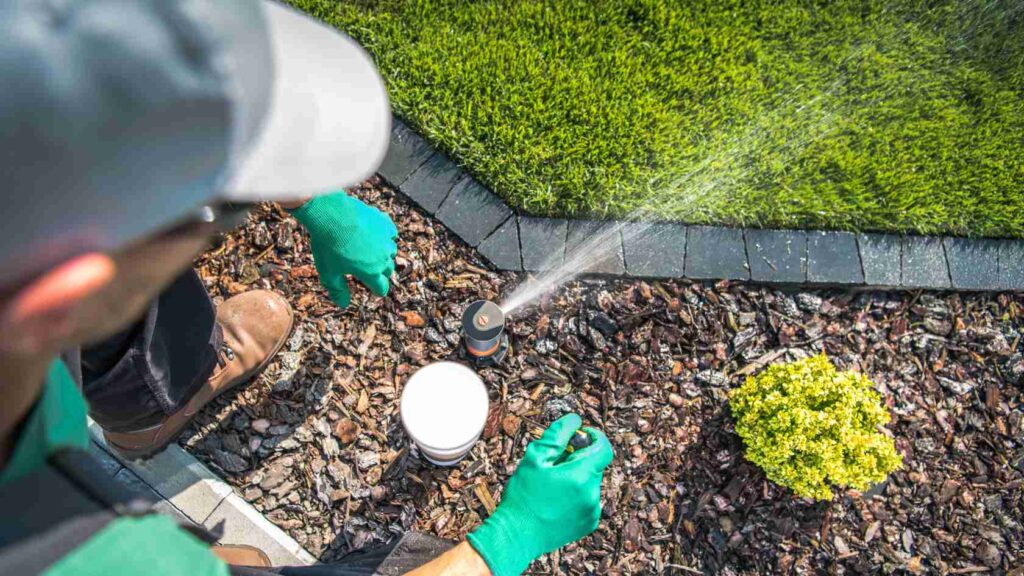Your DIY Guide: How To Fix A Water Sprinkler Head At Home

Ever felt that heart-sinking moment when you see your once vibrant lawn starting to wilt and brown, all because of a faulty water sprinkler head? You’re not alone. This common household issue can turn even the most diligent homeowner’s green thumb pale with worry.
Picture this: it’s a hot summer day, and instead of enjoying an iced tea in your beautiful garden, you’re wrestling with a malfunctioning sprinkler system. No need to despair – there is a way out!
How To Fix A Water Sprinkler Head: sounds complicated, right? But what if I told you there are simple steps anyone can follow – without needing fancy tools or specialist knowledge?
We’ll lift the veil on this topic, offering hands-on advice for evaluating issues with various sprinkler heads, like rotary and fixed-head models. Plus, we’ll guide you through making necessary adjustments.
Table Of Contents:
- Understanding Water Sprinkler Heads
- Common Issues with Water Sprinkler Heads
- Assessing the Problem
- Tools and Materials Needed for Sprinkler Head Repair
- Step-by-Step Guide to Fixing a Water Sprinkler Head
- Maintaining and Preventing Sprinkler Head Issues
- Comparison of Different Sprinkler Head Types
- Choosing the Right Sprinkler Head for Your Needs
- Troubleshooting Common Sprinkler Head Problems
- FAQs in Relation to How to Fix a Water Sprinkler Head
- Conclusion
Understanding Water Sprinkler Heads
Water sprinkler heads are vital components of any irrigation system, helping to maintain lush and vibrant lawns. But what exactly is a sprinkler head? Simply put, it’s the part of your sprinkling system that actually disperses water over your lawn.
Types of Sprinklers
You’ll find two main types in use: rotary sprinklers and fixed-head sprinklers. Rotary versions spin as they spray water across your yard, while fixed-head sprinklers, true to their name, remain stationary.
If you’re dealing with a faulty or broken unit, don’t fret; replacement isn’t overly complicated. To replace a damaged component effectively though requires an understanding of these parts along with how they work.
Rain Bird, for example is one brand offering high-quality replacements which can be used if you have a busted rain bird model on hand.
In both cases—rotary or fixed—you need to match the specs when selecting new ones – including spray pattern and throw distance – otherwise you may disrupt watering consistency across different zones. It’s just like fitting mismatched tires on your car – not something anyone would recommend.
The Riser Factor:
A key player in this process? The humble yet essential riser—the piece that connects the head to its supply pipe. Unfortunately, foot traffic or rowdy mows from lawn care activities often damage them making repairs necessary more frequently than we’d like.
The Connection:
Sometimes problems aren’t due directly to our little friend above ground but instead to its connection below. Sprinkler risers can get cracked or even snap off completely, leading to a broken sprinkler head. This might seem like the end of your lawn care dreams, but fear not. A simple repair process is often all it takes.
The Replacement Process:
When you’re swapping out sprinklers, whether they’re rotary or fixed-head, don’t forget to shut off the main water supply first. Then, move on to digging around the damaged area.
Common Issues with Water Sprinkler Heads
If your lawn looks more like a desert than a lush oasis, you might be dealing with some common water sprinkler head problems. These issues can mess up the spray pattern and water pressure of your system.
Damage from Lawn Mowers
Mowing your lawn should be as harmless to your sprinklers as a butterfly is to a flower. But sometimes, it’s not. One misstep or an incorrectly adjusted blade height on the mower can cause havoc if the sprinkler head sits too high. This results in visible damage that often needs immediate attention.
This problem isn’t exclusive to pop-up sprinkler heads; rotary sprinklers are just as vulnerable. It’s crucial to check each head before mowing for any signs of wear and tear caused by previous mows or foot traffic.
To prevent this issue, make sure all heads are level with or slightly below ground surface when retracted. If needed, adjust them accordingly using garden tools suitable for such delicate tasks.
Clogged Nozzles & Filters
No one likes drinking through a straw filled with debris – neither do our hard-working water sprinkle heads. Clogs in nozzles and filters result in uneven watering patterns and low-pressure streams which could starve sections of your yard of their much-needed drink.
The culprit behind these clogs? Dirt particles carried along by flowing water into small openings within the nozzle assembly where they form obstructions over time.
Spray patterns being thrown off? A blocked filter may need cleaning or replacement – but don’t worry. It’s usually straightforward stuff you could handle without calling professionals unless things go south.
Leaky Seals
Sprinkler heads with leaky seals are like a tap left running – wasteful and annoying. A common sign of this issue is water pooling around the sprinkler even after it has stopped operating, causing soggy patches on your lawn or an unexpected increase in your water bill.
Usually, the culprit is wear and tear or physical damage to the rubber seal inside each head. But don’t worry. The solution isn’t too complex – simply replace the faulty part.
Assessing the Problem
If you’ve noticed your lawn sprinkler isn’t performing as it should, the first step is to figure out what’s wrong. This involves a careful assessment of your system.
Determining Sprinkler Zones
Understanding where each zone begins and ends will help make troubleshooting more efficient. Identifying which region is managed by each zone can be useful for pinpointing problems in your lawn; if something’s not quite right with a certain section, it could possibly be linked to that particular area.
To start, turn on your sprinkler system at the main water supply point. Observe how water sprays from each head and note any irregularities such as weak pressure or misaligned spray direction.
Check for heads that aren’t popping up correctly too. These could indicate blockages or damage in certain zones. Identify the problem & dig.
Finding Visible Issues
The next step is checking for obvious signs of damage on individual parts like broken risers or clogged nozzles which might need replacement. It can be something as simple as debris blocking water flow causing uneven distribution across flower beds and lawns alike.
Sometimes a faulty solenoid might also be responsible for improper functioning since this little device regulates water flow within each valve box connected to vertical pipes running underground throughout different zones in your garden.
Gauging Water Pressure
If all visible parts seem intact but problems persist, then we move onto inspecting pressure levels inside pipes using gauges specifically designed for this purpose. Incorrect readings usually hint towards issues hidden beneath surface level such pipe leaks or obstructed valves reducing overall delivery rate. Identify the problem & dig.
Water pressure problems can be tricky, but once you know where to look and what signs to watch for, they become a lot easier to handle.
Evaluating Spray Pattern
Wrapping up our list, we’re looking at the spray pattern of each sprinkler head. It’s crucial that water is spread evenly across its entire range, leaving no dry spots in between. These gaps could cause uneven grass growth or wilting.
Tools and Materials Needed for Sprinkler Head Repair
To fix a broken or malfunctioning water sprinkler head, you’ll need the right tools. It’s not just about being handy; it’s also about ensuring success in your DIY repair project.
The Importance of the Right Tools
A good set of tools can make all the difference between a quick fix and hours spent wrestling with stubborn parts. So let’s talk about what you’ll need.
Your first friend in this endeavor is a garden spade. This tool will help you to gently excavate around your faulty sprinkler head without causing additional damage to surrounding grass or flower beds.
You might be wondering why we’re emphasizing on ‘gentle’ excavation? Well, beneath every lawn lies an intricate network of pipes connecting each sprinkler head – that includes PVC pipe as well as vertical pipe connections known as sprinkler risers. These components are crucial for proper functioning of individual sprinklers within different zones across your lawn.
Moving forward, one thing that may come in handy is a valve box key – used when needing access to the main water supply control points buried under dirt fall (or soil). This helps us isolate specific sections from the entire irrigation system while making repairs, thereby avoiding unnecessary wet messes.
In addition to these items, other materials needed include replacement heads matching specifications with old ones especially if they were working properly before getting damaged. You’ll want something similar in terms of spray distance and delivery rate so there isn’t any disparity amongst neighboring sprays after repair work gets done. Replacement heads, depending upon type whether rotor types like Rain Bird models or pop-up varieties could be procured easily at local hardware stores or online retailers too.
For any necessary adjustments, you’ll need a few essential tools such as screwdrivers and pliers. These include screwdrivers for adjusting spray direction and pliers to tighten or loosen parts as needed.
Sprinkler Head Repair – It’s Not Rocket Science.
Having the right tools and materials can make sprinkler head repair pretty straightforward. Don’t fret if you don’t possess expertise yet – this guide is here to assist, and we think that even novices will swiftly become accustomed to it.
Step-by-Step Guide to Fixing a Water Sprinkler Head
Sprinkler head problems can be frustrating. Don’t be concerned, we’ve got you covered. Here’s a simple process that will help you fix the common sprinkler head problem like a pro.
Identify and Remove Broken Sprinkler Head
The first step is identifying the faulty part. You’ll need to examine each individual sprinkler in your lawn carefully for any signs of damage or malfunction.
If you spot an issue, get ready to remove it. Twist off the broken head counterclockwise from its base (the ‘sprinkler riser’). Be careful not to let dirt fall into the supply pipe while doing this.
Selecting Replacement Head
Picking out a replacement sprinkler isn’t just about grabbing one off the shelf. The spray distance and delivery rate should match those of other heads rotor in your system, ensuring uniform spray across all areas. This guide can give more insight on choosing replacements based on specifications such as throwing distance or type (pop-up vs fixed-head).
Fitting New Sprinklers
To install new parts labor effectively, start by screwing in your new pop-up or fixed head clockwise onto the existing riser; again making sure no dirt enters during this phase. For clogged sprinklers where replacing isn’t necessary, a tool cut into wire shape could do wonders – gently insert it into nozzle hole sprinkle, ridding them of debris accumulation which often impedes water flow.
Adjustments: Spray Direction & Distance Control
Your next task involves fine-tuning so everything works properly once again. The topmost screw allows control over directionality & volume delivered per rotation or spray – adjusting these could rectify issues with watering patterns that seem off. Here’s a detailed guide on how to adjust the direction and distance of your sprinkler heads.
Test Run
Check to see if the system is operating optimally. Flip on your water supply and give the new shower head a look-over. Is the flow even? Does it have good pressure? How about coverage?
Maintaining and Preventing Sprinkler Head Issues
Proper care of your sprinklers is vital to keeping them in tip-top shape. Performing regular upkeep can be beneficial for the health of your lawn, especially when it comes to avoiding potential issues. Let’s discuss some ways to keep your sprinklers in peak condition.
Regular Cleaning of Sprinklers
The lifeblood of any good sprinkler system is clean water flowing through a clear supply pipe. Dirt or debris clogging up the works? That spells trouble for uniform spray from head sprinklers.
To keep things running smoothly, make sure to regularly inspect each individual sprinkler for signs of dirt or grime buildup. It’s also crucial not just for pop-up models but fixed-head ones too. Clear away any gunk with an old toothbrush – don’t be afraid to get into those nooks and crannies.
If cleaning doesn’t do the trick, it might be time to consider replacement heads. When picking out new ones though, remember that throwing distance matters. The new one should have similar coverage as the old one; otherwise, you risk leaving parts of your yard high and dry (literally).
Avoid Over-Extension
Another common problem occurs when a sprinkler riser extends too far above ground level – making it an easy target for damage by foot traffic or worse yet…the dreaded lawnmower blade.
An effective solution here is using cutoff risers instead. These handy tools let you adjust how much head sits above ground level which helps prevent accidental damage while ensuring optimal delivery rate.
Routine Inspections
No matter how well we maintain our systems sometimes issues will still crop up because even rain bird isn’t immune to wear and tear. To catch these problems early, make it a habit to inspect your sprinkler system regularly.
Watch out for sprinkler heads that are broken or not popping up correctly – sometimes, the issue can be as basic as a dirt-clogged hole in the head. Also, pay attention to any parts of your lawn that appear drier than others. These could indicate problems with water supply due to pipe-related issues or defective solenoids within individual units.
Comparison of Different Sprinkler Head Types
When it comes to watering your lawn, the type of sprinkler head you use can make a big difference. Various types of sprinkler heads are available, each offering its own advantages and uses.
Differences Between Rotary and Fixed-Head Sprinklers
Rotary sprinklers, also known as pop-up sprinkler heads, emerge from the ground when activated by water pressure. They rotate in a circle while spraying water at a distance. These types excel at covering large areas like parks or sports fields.
In contrast, fixed-head sprinklers, stay in one position without moving parts. The spray pattern is set upon installation making them great for small lawns or flower beds where precision is needed more than range.
The choice between these two largely depends on your specific needs – do you need to cover a wide area efficiently? Or are there particular zones that require focused watering?
Here’s an article that delves deeper into choosing between rotary and fixed-head sprinklers based on their characteristics.
Spray Distance And Delivery Rate
A critical aspect to consider when comparing different sprinkle heads is their throwing distance and delivery rate – this will directly impact how well they can irrigate your landscape.
For instance, if you have larger grassy areas or wider flower beds needing uniform spray coverage, rotary sprayers would be ideal due to their longer throw distance.
However for smaller spaces requiring precise irrigation patterns such as around sidewalks or driveways; fixed head ones might serve better because they deliver concentrated sprays within defined perimeters.
Picking The Right Replacement Sprinkler Head
If your existing unit gets damaged, finding a replacement sprinkler head that matches the old one’s specifications is crucial. This ensures your system maintains its original performance and efficiency.
While replacing, it’s important to note that not all heads are created equal – some might have higher water delivery rates while others may boast of wider spray distances. Before making a purchase, it’s important to check for parameters such as water delivery rate and spray distance in order to find the most suitable solution.
Choosing the Right Sprinkler Head for Your Needs
Navigating the sprinkler aisle at your local home improvement store can be a daunting task, with an extensive selection of options available. The key to making sense of it all? Understanding that each type is designed with specific needs in mind.
Matching Specifications with Old Heads
To determine which replacement head to select, examine the existing one’s spray pattern, throwing distance and delivery rate. Take note of its spray pattern, throwing distance, and delivery rate because these are vital aspects when selecting a new one. Remember, consistency across your system will give you more uniform spray coverage and help maintain balanced water pressure throughout.
In case your existing sprinkler heads are pop-up types or rotary ones, make sure their replacements match not only by type but also by specifications. Replacing pop-up sprinklers with rotors or vice versa without considering matching specs can lead to uneven watering or potential damage due to differences in water pressure requirements.
A good rule thumb: If something worked well before – stick with it. But if changes need be made – such as increasing throw distance for growing flower beds – ensure adjustments align overall system design considerations like supply pipe capacity.
Finding the Perfect Fit
Beyond specifications though lies another critical factor: suitability for purpose. Here’s where understanding different types comes into play; whether they’re fixed head sprinklers used typically lawns or specialty variants tailored unique landscapes features like slopes ditches around ponds etc., getting right fit crucial achieving optimal performance from irrigation system so knowing which one suits best could save headaches down road .
For instance rotating heads are great for larger areas thanks their extended range while fixed-heads better suited smaller patches where precision is key. Pop-up heads meanwhile excel at staying out of harm’s way when not in use, popping up only when it’s time to water.
So while your old head’s specs can guide you, don’t be afraid to explore if changes might benefit your specific needs.
Balancing Cost and Value
Even though sprinkler repair or replacement might seem like a breeze, the costs can really pile up. You’ve got to think about parts and labor, especially when you’re dealing with more sophisticated systems.
Troubleshooting Common Sprinkler Head Problems
Are you tired of dealing with sprinkler head problems? Don’t worry. This section will help you tackle common issues like a pro. Let’s get to work and restore your system to its optimal condition.
The Infamous Broken Sprinkler Heads
Sprinklers, just like any other mechanical device, can break down over time. A broken head is one such nuisance that interrupts the water flow in individual sprinkler zones. Whether it’s due to foot traffic or a mischievous lawnmower, sprinkler heads often bear the brunt of damage.
If your turf looks more like a haphazard pond than an orderly garden, it’s likely you’re experiencing this problem. But fear not. Replacing these culprits usually does the trick.
Clogged Nozzles: The Silent Water Thieves
Imagine pouring energy into maintaining lush flower beds only for them to wilt because they didn’t receive enough water supply from your clogged sprinklers – sounds frustrating right?
Clogging can occur when dirt falls into the nozzle during installation or repair work on surrounding parts laboring under ground level conditions. Sometimes even mineral deposits from hard water can choke your nozzles causing irregular spray distance and uneven watering patterns across different areas.
Misaligned Spray Patterns
Your pop-up sprinklers were working properly last week but now their spray direction seems all over the place – sound familiar? Misalignment may be behind such inconsistencies in throwing distance leading to patches of dry grass amidst well-watered sections.
Regular maintenance checks are essential, as adjustments made at regular intervals prevent such hiccups before they escalate into larger sprinkler problems.
Water Pressure Woes
Balancing water pressure and sprinkler settings ensures that your yard gets just the right amount of water, without any wastage or dry spots. So remember, fine-tuning both aspects is key to a healthy and well-irrigated lawn.
FAQs in Relation to How to Fix a Water Sprinkler Head
How do you fix a water sprinkler head?
You can fix it by first identifying the problem, gathering necessary tools and parts, then following step-by-step repair instructions. Sometimes just cleaning or adjusting may solve your issue.
What causes a sprinkler head to not work?
Sprinkler heads often stop working due to clogs from dirt or debris, damage from lawn mowers or foot traffic, misalignment issues, or broken components within the system itself.
How do you fix a sprinkler head that is not rotating?
To fix a non-rotating sprinkler head, check for debris in the gear mechanism. If clean but still stuck, replace with an identical model ensuring matching spray patterns and distances.
Conclusion
Repairing a water sprinkler head is no longer a mystery. We’ve given you the knowledge to understand different types of heads, how they function, and common issues they face.
You now know how to diagnose problems with your sprinkler system effectively. From spray pattern irregularities to pressure inconsistencies – we covered it all!
We armed you with practical tools and materials for fixing any broken or malfunctioning sprinkler head at home. How To Fix A Water Sprinkler Head? You got this! No more worries about wilting lawns in hot summers.
The importance of maintaining your watering system has been emphasized too – clean regularly, adjust as needed, prevent future hiccups.
Remember that picking the right kind of head for your lawn’s needs can make a huge difference in performance and longevity. And finally…
Troubleshooting doesn’t need to be intimidating anymore; because when problems arise (and they will), remember: For those occasions when issues arise, our comprehensive guide is at the ready.
As an Amazon Associate, we earn from qualifying purchases. Affiliate links help support our work and allow us to continue providing free content. If you make a purchase through an affiliate link, we receive a small percentage of the sale at no extra cost to you.
The DIY repair advice on this site is for informational purposes only. The content aims to be helpful but cannot guarantee success or substitute professional advice. Any repairs involve some risk, so readers assume all liability and responsibility for their actions. Safety should be the top priority. If unsure about any procedure, first consult a qualified professional to determine suitability.
- Sprinkler Rebate Guide
- Slash Your Water Bill and Save the Planet with Sprinkler Rain Sensors!
- How to Revive a Lawn: Bringing Your Drought-Stricken Lawn Back to Life
- Sprinkler Repair Costs: The Shocking Truths You Need to Know!
- Gardeners Won’t Believe These Raised Bed Irrigation System Hacks!
- 11 Shocking Secrets to Buying the Perfect Sprinkler Heads
- A Comprehensive Guide on How to Adjust the Rainbird 5000 Sprinkler Head
- The Complete Step-by-Step Guide to Design a Sprinkler System
- Residential Sprinkler Head Types: A Comprehensive Guide
- Thank You For Subscribing




